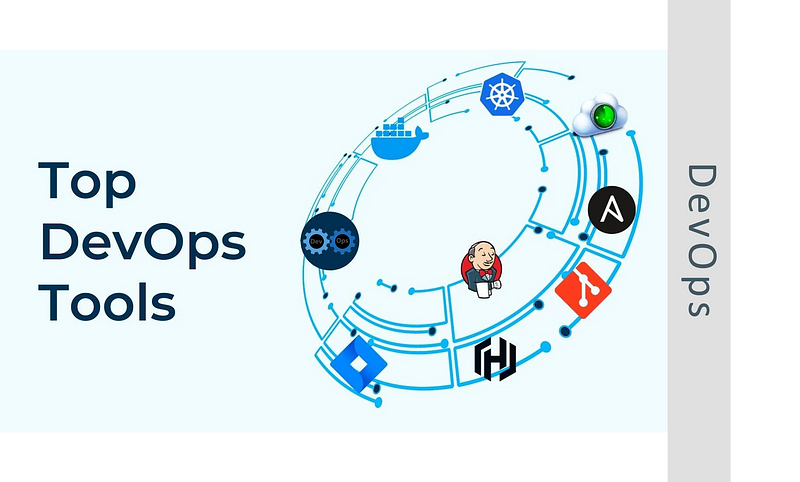Top 10 Essential DevOps Tools for 2023: A Comprehensive Guide
Written on
Chapter 1: Introduction to DevOps Tools
DevOps tools play a crucial role in speeding up software development and delivery, often operating behind the scenes to automate and optimize various processes. These digital champions help improve software quality, accelerate feature launches, and boost application reliability and scalability.
In this article, we will explore the dynamic world of DevOps and identify ten essential tools that are set to make a significant impact in 2023. These tools are not merely trendy; they are vital for nurturing a strong DevOps culture within your organization.

Chapter 2: Terraform - Shaping Infrastructure as Code
Kicking off our list is Terraform, a leading open-source tool for infrastructure as code (IaC). It allows you to define your infrastructure in a code format, ensuring a consistent and repeatable deployment process.
With Terraform, you can manage a diverse range of infrastructure elements, from virtual machines to networking components, and deploy applications seamlessly across cloud platforms like AWS, Azure, and Google Cloud.

Why Terraform is Essential:
- Consistency: Ensures uniform deployment of infrastructure.
- Repeatability: Easily replicate infrastructure across environments.
- Version Control: Keep track of infrastructure changes in code.
- Collaboration: Enhance teamwork on infrastructure definitions.
Chapter 3: Kubernetes - Orchestrating Containers
Next up is Kubernetes, an open-source platform for container orchestration. It is invaluable for managing and deploying containerized applications at scale.
Key Benefits of Kubernetes:
- Scalability: Adjust application scale according to demand.
- Reliability: Automatic recovery and node rescheduling.
- Efficiency: Streamline management of container resources.
- Portability: Deploy applications on any Docker-compatible platform.
Chapter 4: Docker - The Future of Containerization
Our third tool is Docker, an open-source platform that allows you to package applications into lightweight, portable containers.
Strengths of Docker:
- Portability: Run containers across any Docker-supported infrastructure.
- Scalability: Easily adjust containers for cloud-native applications.
- Efficiency: Optimize resource use to save costs.
- Reproducibility: Create new containers from existing ones effortlessly.
Chapter 5: Ansible - Automating with Ease
Ansible, an open-source automation tool, follows next. It simplifies processes such as provisioning, configuration, and deployment.

Why Ansible is Valuable:
- Automation: Streamline tasks for enhanced efficiency.
- Simplicity: User-friendly, even for beginners in automation.
- Agentless: Manage systems without needing agents on target machines.
- Scalability: Easily manage large numbers of systems.
Chapter 6: Jenkins - The CI/CD Champion
Jenkins, a cornerstone in the DevOps landscape, is our fifth tool and an open-source solution for continuous integration and continuous delivery (CI/CD). It's ideal for automating the software build, testing, and deployment processes.
Advantages of Jenkins:
- Automation: Fully automate the CI/CD pipeline.
- Flexibility: Customize Jenkins to fit your organization's needs.
- Scalability: Efficiently handle extensive CI/CD workflows.
- Community Support: Access a robust community for assistance.
In addition to CI/CD, Jenkins can automate other tasks, such as running integration tests and generating reports.
Chapter 7: Prometheus - Monitoring Your Systems
Prometheus, a powerful open-source monitoring and alerting tool, ranks sixth. It excels at collecting metrics and logs from various applications and infrastructure, enabling proactive alerts based on this data.
Why Prometheus is Effective:
- Flexibility: Monitor a wide variety of metrics and logs.
- Scalability: Easily expand to monitor multiple systems.
- Open Source: Free to use and modify.
- Community Support: Benefit from an engaged user community.
Chapter 8: Grafana - Visualizing Your Data
Seventh on our list is Grafana, an open-source data visualization tool that creates a visual interface for the metrics and logs collected by Prometheus and other monitoring tools.
Distinct Features of Grafana:
- Powerful Visualization: Build custom dashboards for your data.
- Flexibility: Visualize data from various sources like Prometheus and AWS CloudWatch.
- Open Source: Free to customize and use.
- Community Support: Join a large and active Grafana community.
Chapter 9: Nagios - Comprehensive Monitoring
Nagios comes in at eighth place as an open-source monitoring and alerting system, focusing on the availability and performance of applications and infrastructure.
Strengths of Nagios:
- Comprehensiveness: Monitor a wide array of applications and infrastructure.
- Flexibility: Customize to fit your organization’s unique requirements.
- Open Source: Modify and use freely.
- Community Support: Access to a supportive community.
Chapter 10: Splunk - Data Insights Unleashed
Splunk, a commercial data analytics platform, takes the ninth position. It enables users to search, analyze, and visualize data from various sources, including logs and application metrics.
What Makes Splunk Stand Out:
- Advanced Search and Analytics: Quickly find and analyze the necessary data.
- Scalability: Handle large volumes of data from numerous sources.
- Visualization: Create detailed dashboards and reports.
- Security: Robust features to protect your data.
Chapter 11: PagerDuty - Incident Response Made Easy
Rounding out our list is PagerDuty, a commercial incident response platform that streamlines incident alerts and team coordination during critical situations.

Key Features of PagerDuty:
- Incident Alerting: Notify teams through phone, email, and SMS.
- Incident Management: Centralize incident management for better collaboration.
- Escalation: Automatically escalate incidents based on severity.
- Reporting: Access various reports to track incident trends.
Conclusion
The DevOps landscape continues to evolve, making it essential to stay informed about the latest tools available. Each of these ten tools offers unique benefits that address different facets of the DevOps pipeline. By integrating the right mix of these tools, organizations can significantly enhance their DevOps journey in 2023.
This video discusses the best DevOps tools, platforms, and services for 2023, providing insights into how they can enhance your development processes.
This video covers the top 10 DevOps tools that you should learn about, explaining their significance in the modern development landscape.